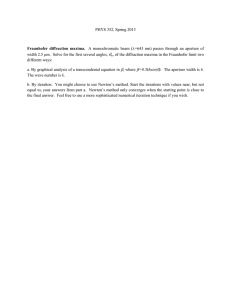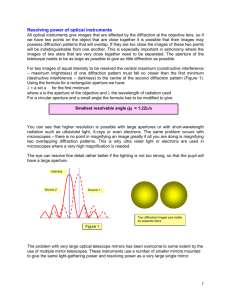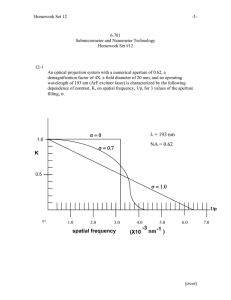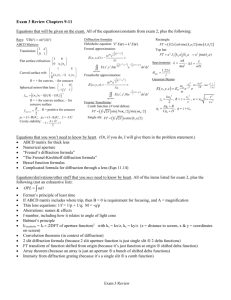471/Lectures/notes/lecture 31c Fraunhofer diffraction.pptx
advertisement
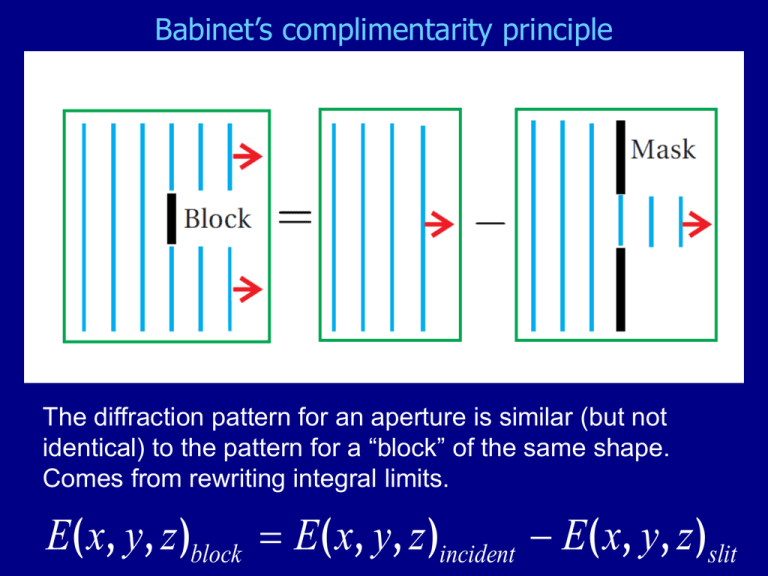
Babinet’s complimentarity principle The diffraction pattern for an aperture is similar (but not identical) to the pattern for a “block” of the same shape. Comes from rewriting integral limits. E( x, y, z)block E( x, y, z)incident E( x, y, z)slit Babinet’s principle for complementary patterns E( x, y, z)both E( x, y, z)square E( x, y, z)circ I both E( x, y, z)square E( x, y, z)circ 2 Atmospheric “corona” caused by diffraction around uniform droplets or ice particles Review of Fresnel approximation E x, y, z ieikz e i k 2 2 x y 2z z E x, y, 0 e i k x 2 y 2 2z e i k xx yy z dxdy aperture Approximation made: z > aperture size, interference pattern size For I on screen at z, we can ignore the factors in front I x, y, d E x, y, 0 e k i x 2 y 2 2z e k i xx yy z aperture (We only need the factors in front if we interfere the diffracted light with another source) 2 dxdy Next approx as z gets bigger (or aperture smaller) Which goes to zero faster as z gets big (and why)? A. B. k 2 2 x y 2z k xx yy z Fraunhofer approximation: e i k x 2 y 2 2z e i k xx yy z Rough boundary between Fresnel and Fraunhofer diffraction: Or: for big z, the aperture-screen length 2 aperture size differences between any 2 points on the z aperture becomes less than /2… (the center can’t become dark)! Diffraction for increasing screen distance Looks like the aperture with fringes! (Fresnel) Aperture 200x100 /2p z screen 20 /2p z screen 100 /2p “Far field” looks like |FT|2 of aperture! Fraunhoffer diffraction) z screen 500 /2p z screen 2500 /2p Fraunhofer angular form EFraun x, y, d ( phase factor) E x, y, 0 e i k xx yy z dxdy aperture EFraun x , y ( phase factor) E x, y, 0 e ik x x y y aperture EFraun x , y ( phase factor) FT E( x ', y ') I Fraun x , y FT E( x ', y ') 2 dx dy Rectangular slit EFraun x , y aperture E x, y, 0 e ik x x y y dx dy Square aperture plots Square aperture Zooming in… The square diffraction pattern is shown on the left. Which pattern on the right belongs to the rectangular aperture shown? A) top B) bottom Fraunhofer diffraction of a very tall slit, uniformly illuminated EFraun x , y aperture E x, y, 0 e ik x x y y dx dy Single slit Fraunhoffer diffraction In reality just need to illuminate slit by beam >> slit width: Angular scale of diffraction How big should we expect the pattern to be on the screen? What is the average change of angle of a photon? What should it depend on? a Can use photon momentum uncertainty a Two interference views of Fraunhoffer diffraction 1. Huygen’s wavelets in the aperture weighted by Eaperture[x’,y’] interfere to give Escreen[x,y] 2. Reverse time: Plane waves coming from screen at angle x,y weighted by Escreen[x,y] interfere to give Eaperture[x’,y’] ! a Can laser beams propagate without spreading? Use angular scale of diffraction Diffraction of a “Gaussian aperture” A laser beam has a Gaussian profile of 2mm width, and a constant phase across the beam. How wide will it be after propagating 100m? Fresnel vs Fraunhofer Figures in order were made by increasing something. Which could it be? a) a b c) z Review of approximations, regimes z > aperture size > ei( kr t ) 1 cos r , ˆz 2 dx ' dy ' E x, y, z E x, y, 0 r aperture z > aperture size, z > interference pattern size: E x, y, z Fresnel eikz e i k 2 2 x y 2z E x, y , 0 e i k x 2 y 2 2z e i k xx yy z dxdy aperture z > (aperture size)2 / : EFraun x, y, d ( phase factor) E x, y, 0 e i k xx yy z dxdy aperture EFraun x , y ( phase factor) aperture ik x x y y E x , y ,0 e dxdy Atmospheric (pilot’s) “Glory” Light scattered back from droplets Complicated mixture of diffraction and refraction: For a recent discussion (2012) of “glory” physics see http://www.scientificamerican.com/article.cfm?id=the-science-of-the-glory&page=1
